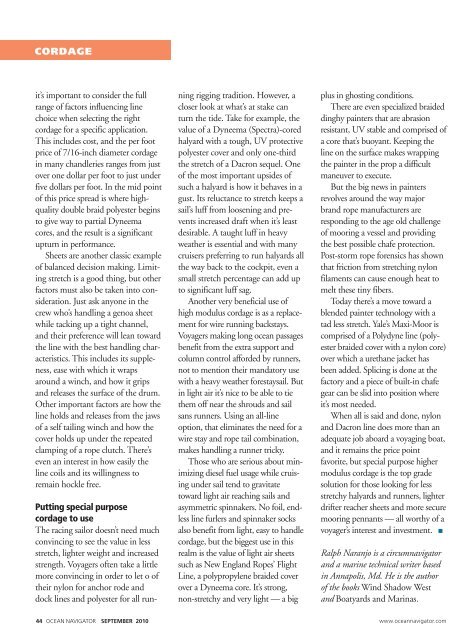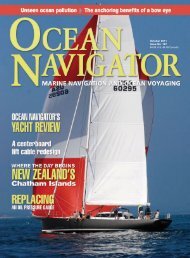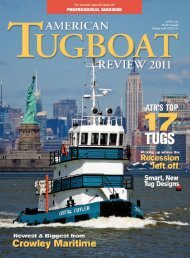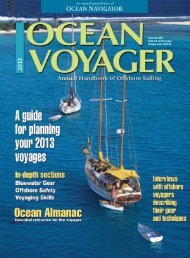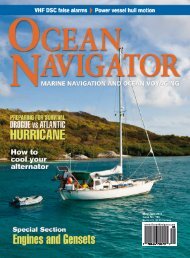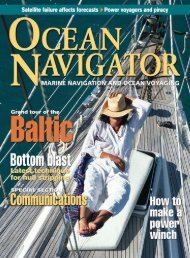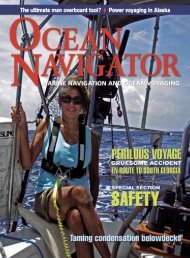Ask For A Test Demo - Navigator Publishing
Ask For A Test Demo - Navigator Publishing
Ask For A Test Demo - Navigator Publishing
You also want an ePaper? Increase the reach of your titles
YUMPU automatically turns print PDFs into web optimized ePapers that Google loves.
CORDAGEit’s important to consider the fullrange of factors influencing linechoice when selecting the rightcordage for a specific application.This includes cost, and the per footprice of 7/16-inch diameter cordagein many chandleries ranges from justover one dollar per foot to just underfive dollars per foot. In the mid pointof this price spread is where highqualitydouble braid polyester beginsto give way to partial Dyneemacores, and the result is a significantupturn in performance.Sheets are another classic exampleof balanced decision making. Limitingstretch is a good thing, but otherfactors must also be taken into consideration.Just ask anyone in thecrew who’s handling a genoa sheetwhile tacking up a tight channel,and their preference will lean towardthe line with the best handling characteristics.This includes its suppleness,ease with which it wrapsaround a winch, and how it gripsand releases the surface of the drum.Other important factors are how theline holds and releases from the jawsof a self tailing winch and how thecover holds up under the repeatedclamping of a rope clutch. There’seven an interest in how easily theline coils and its willingness toremain hockle free.Putting special purposecordage to useThe racing sailor doesn’t need muchconvincing to see the value in lessstretch, lighter weight and increasedstrength. Voyagers often take a littlemore convincing in order to let o oftheir nylon for anchor rode anddock lines and polyester for all run-ning rigging tradition. However, acloser look at what’s at stake canturn the tide. Take for example, thevalue of a Dyneema (Spectra)-coredhalyard with a tough, UV protectivepolyester cover and only one-thirdthe stretch of a Dacron sequel. Oneof the most important upsides ofsuch a halyard is how it behaves in agust. Its reluctance to stretch keeps asail’s luff from loosening and preventsincreased draft when it’s leastdesirable. A taught luff in heavyweather is essential and with manycruisers preferring to run halyards allthe way back to the cockpit, even asmall stretch percentage can add upto significant luff sag.Another very beneficial use ofhigh modulus cordage is as a replacementfor wire running backstays.Voyagers making long ocean passagesbenefit from the extra support andcolumn control afforded by runners,not to mention their mandatory usewith a heavy weather forestaysail. Butin light air it’s nice to be able to tiethem off near the shrouds and sailsans runners. Using an all-lineoption, that eliminates the need for awire stay and rope tail combination,makes handling a runner tricky.Those who are serious about minimizingdiesel fuel usage while cruisingunder sail tend to gravitatetoward light air reaching sails andasymmetric spinnakers. No foil, endlessline furlers and spinnaker socksalso benefit from light, easy to handlecordage, but the biggest use in thisrealm is the value of light air sheetssuch as New England Ropes’ FlightLine, a polypropylene braided coverover a Dyneema core. It’s strong,non-stretchy and very light — a bigplus in ghosting conditions.There are even specialized braideddinghy painters that are abrasionresistant, UV stable and comprised ofa core that’s buoyant. Keeping theline on the surface makes wrappingthe painter in the prop a difficultmaneuver to execute.But the big news in paintersrevolves around the way majorbrand rope manufacturers areresponding to the age old challengeof mooring a vessel and providingthe best possible chafe protection.Post-storm rope forensics has shownthat friction from stretching nylonfilaments can cause enough heat tomelt these tiny fibers.Today there’s a move toward ablended painter technology with atad less stretch. Yale’s Maxi-Moor iscomprised of a Polydyne line (polyesterbraided cover with a nylon core)over which a urethane jacket hasbeen added. Splicing is done at thefactory and a piece of built-in chafegear can be slid into position whereit’s most needed.When all is said and done, nylonand Dacron line does more than anadequate job aboard a voyaging boat,and it remains the price pointfavorite, but special purpose highermodulus cordage is the top gradesolution for those looking for lessstretchy halyards and runners, lighterdrifter reacher sheets and more securemooring pennants — all worthy of avoyager’s interest and investment. ■Ralph Naranjo is a circumnavigatorand a marine technical writer basedin Annapolis, Md. He is the authorof the books Wind Shadow Westand Boatyards and Marinas.44 OCEAN NAVIGATOR SEPTEMBER 2010www.oceannavigator.com


